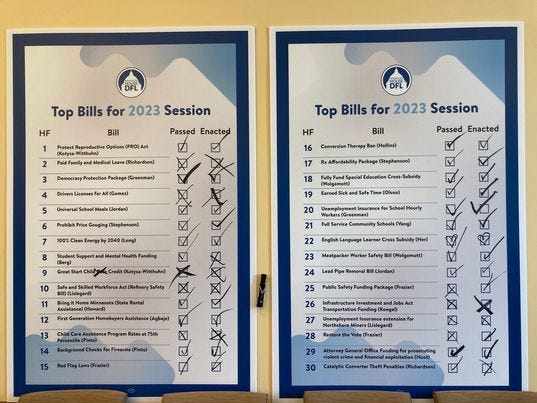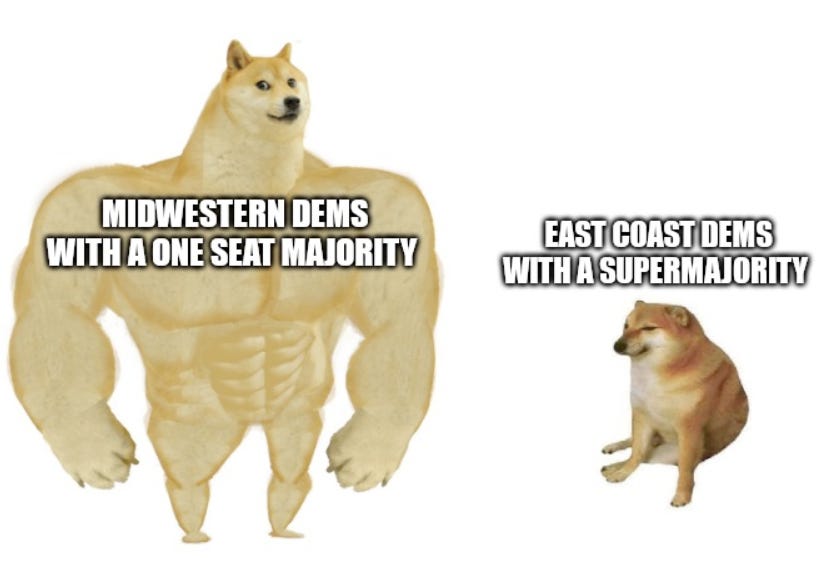Signs of Hope: Minnesota, Take Two
The Minnesota legislative session just ended. There's a lot of good news to celebrate.
Shout Out to my friend Sarah Keuper, who’s a bit more directly plugged in to state government activity these days, for some useful links and in general for the reminder that we have a lot of wins to celebrate!

I’ll admit it, I’ve been despairing a bit this week. The fascists have been winning a lot, in a lot of states. I came very close to making a very fighty-fighty post about it, and I might still, because…we’re going to be fighting, soon, and it’s time to face that.
But right now? Instead, let’s celebrate a whole lot of wins for the Good Guys1.
State of play
Minnesota, as I’ve mentioned before, has not just a DFL2 trifecta, right now, but a progressive DFL trifecta. The majority is narrow, but somehow, it’s managed to hold together in a way other Democratic trifectas can’t seem to manage; and push an agenda it didn’t even try for back in the 2013-2014 session, the last time the DFL had the trifecta.
This is not to say that Minnesota is an absolute, wall-to-wall bastion of progressiveness. We’re also the state of Tom Emmer and Michelle Bachmann, after all.
But the DFL gained current trifecta in the 2022 election by running on an explicitly progressive platform. And now, it can run again on having actually delivered on a lot of that program.

As this article from the Minnesota Reformer points out, the DFL accomplished this the old-fashioned, activist way. They won their seats through grass-roots organizing, and running on explicitly progressive messages. They didn’t tack to center and then break left. They ran left, and they delivered from the left. Once in office, they didn’t let themselves get broken up into sub-factions—something the New York State Democrats do continually.
They also didn’t do what the DFL trifecta of 2013-2014 did—pass a few progressive acts, but mostly play it safe, hoping to protect their power by not alienating conservatives. Conservatives, particularly in rural districts, broke hard-right anyway, especially once Trump came on the scene. As a result, the trifecta was short and mostly forgotten.
In short, in trying to preserve their political capital, they squandered it.
So instead, a progressive core pushed a progressive agenda on a Scandinavian model: let the government actually spend money to help people. Rather than hoard their political capital, they chose to invest it in getting things done.
Now, an investment is just another word for a gamble, a bet. This is as true for political investments as for the stock market. Sometimes, you get a return on your investment; sometimes, you lose your shirt. What’s remarkable about this session is that the Minnesota DFL had confidence in their game, and went all-in.
Highlight reel
And what did they invest in?
Well, to start with, at a time when Red States are pushing a fascist, genocidal agenda against the LGBTQ+ community, Minnesota declared itself a sanctuary state that would not enforce any warrant coming out of the red states. Not only are Minnesota children and their parents protected from conversion therapy and allowed to seek gender affirming care, but people coming here from other states will be protected. The same for people coming here to seek abortion care. I talked about this last time (see the link above).
But there was a lot more.
Education, infrastructure, transportation
There was a huge investment in education—nearly $2 billion. This includes more money for teachers, for facilities, and a big boost for reading reform. It also includes free access to menstrual products for students, and free school meals for students who are part of the federal School Breakfast Program, covering the difference between what the feds provide, and what the meal costs. Educational funding is now indexed to inflation, so it won’t get badly out of step, as it has done lately.

There were a lot of significant investments in infrastructure, for a lot of different definitions of “infrastructure”. A huge bonding bill passed. This is a particularly big deal, since bonding bills in Minnesota require super-majorities. That mean at least a few members of the GOP caucus in both houses had to agree! The bond issue will fund all kinds of public services, from roads and bridges, to college buildings, to plumbing.
A separate set of transportation bills will raise money for transportation projects using a package delivery fee and a metro-county sales tax bump. The gas tax was not entirely left off the hook—it’s now inflation linked—but since the price of gas has been relatively steady through the latest inflation curve, that’s not the projected source of most of the transportation funds.
Part of that transportation funding will go toward a long-standing dream project, the Northern Lights Express. This will be a regular passenger train service between the Twin Cities (terminating at Target Field) and Duluth, with a proposed one-way fare of $30-353. People have been thinking this line is a no-brainer for years, but “no-brainer” does not mean “free”. Now, the money is committed. The Federal government is pledging 4-to-1 matching, automatically. This means that, unless something goes badly wrong during the design phase, the route’s creation is assured.

Voting and housing
Minnesota was already one of the easiest states to register to vote in—we’ve had “motor-voter” rules, where you could register when you obtain, update, or renew your driver’s license, for ages. Now, every Minnesotan the government has any reason to know exists, by any means, will automatically be registered as a voter. Not registered to vote, but you just filed for unemployment? Now, you’re registered to vote, too. Minnesota also made permanent its rules for absentee voting, and will now allow 16-year-olds to pre-register to vote, so that they’re fully eligible as soon as they turn 18.
While they were at it, a new law altered when released felons have the franchise restored to them. Previously, it was at the end of their probation; now, it will be upon release from prison. There was a case before the Minnesota Supreme Court arguing for this change, which the court heard, but has spent a surprising 14 months not deciding upon. The court made it clear it very much wanted this to be a legislative decision, so the legislature decided.
Until now, there was no money dedicated to affordable housing in Minnesota. To be fair, until the last decade, Minnesota housing was already pretty affordable, but now, it’s caught up or surpassed the national average housing costs. The legislature set aside one billion dollars as a dedicated source of funds. It also funded a lot of services related to housing issues, including various shelters for unhoused people, troubled youth, and for people trying to escape abuse and trafficking.
Legal weed
OK, I care less about this one, personally, because I don’t partake. However, after having stealth-legalized edibles last session, this year’s session legalized, regulated, and applied taxation to cannabis. Dispensaries are expected to be licensed and running by 2024, but there are provisions for limited home-growing for personal consumption.
What I do care a lot about, however, is the expungement clause included in the law. This will automatically clear all state misdemeanor marijuana charges, and set up a review board for expunging felony charges on a case-by-case basis—presumably, people convicted in the past for things that will still be a crime would not be expunged, for example.
Why do I care about this? Because like almost all drug crime law, convictions on cannabis crimes fall disproportionately upon people of color. It’s always been deeply unjust, and now, an effort to fix it is being made.
PTO!
Remember what I’ve said before? Take your PTO!
Well, the State of Minnesota agrees with me. Effective 1 January 2024, anyone in the state who works for an employer for more than 80 hours in a given year (so, you know, two full-time weeks) must be offered paid sick-and-safe time at a rate of at least 1 hour off for every 30 worked.
Now, we have to actually make it work!
I could go on and on. There was a lot more! I will link several articles below for people who want to see all the stuff that got through and signed. It’s a lot! A lot a lot.
Now, however, comes the hard part, As the same article linked above from the Reformer points out, the investment has to actually pay off. Housing needs to get more affordable. Learning outcomes need to measurably improve. Roads, bridges, trains all need to get visibly better. In short: the Scandinavian model is not just about taxing a bit more and spending a lot more. It’s about actually getting something for the money, a return on the investment.
If the bet succeeds, Minnesota’s quality of life—already one of the best in the nation4—stands to improve significantly. With luck, Minnesota’s model can provide a guide-star for other states looking to counter the GOP’s insanity.
Links
MinnPost has a Guide to the Legislature’s “done” and “undone” lists.
The American Prospect talks about The New Minnesota Vikings, pointing out the Nordic roots of Minnesota progressivism.
The Minnesota Reformer, as linked above, helped provide me the theme that this was a bet, or as I prefer to think of it, an investment, in ourselves.
The Minneapolis Star-Tribune has a more mainstream article about the DFL celebrating its wins, with some notes about how the GOP plans to campaign on the ways it spends too much5.
The Strib also has a good explainer specifically about the legalized marijuana law.
Just to be clear, if you’re lost and confused, Good Guys, in this newsletter, will always refer to progressives, and Good Stuff to their policies and politics. Bad Guys and Bad Stuff will always refer to regressive fascist MAGA bullshit. If that’s not your mug of meat, you’re in the wrong place! ↩
For non-Minnesotans who haven’t seen this before, Minnesota doesn’t have a Democratic Party; it has a Democratic-Farmers-Laborers party. ↩
I’m not gonna lie: if the fare stays that low once the thing is in operation, I’ll probably occasionally get on the train just to ride a train for a day. I love trains! ↩
US News rankings for example ↩
One interesting facet of this: so far, the GOP counterarguments appear to be strictly fiscal. So far, at least, we’re not hearing a lot of bleating about the sanctuary laws, for example. Maybe I’m just missing it (entirely possible). ↩

